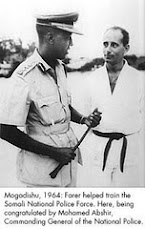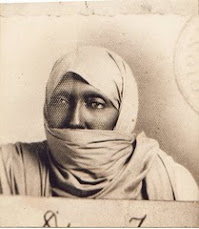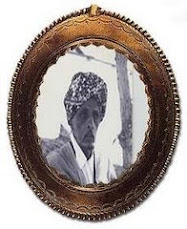The story of Somalia’s troubles can be read in the decay of its capital, Mogadishu. As the country is once more gripped by drought, Xan Rice charts its downfall.
I was new to Somalia and Mohamed Abbi, a tombstone-toothed,
guitar-plucking security guard, was telling me some important truths.The first was that if he crossed the invisible line that divided
Galkayo, the scruffy town that I was visiting, he would be killed.
This was nothing personal, Abbi explained. Most of the town's
residents were either Darod or Hawiye, two of Somalia's main clans. The
people looked the same, spoke the same language, and were all Muslims.
Yet the Darods, including Abbi, were confined to north Galkayo, the
Hawiyes to the south.
“If I had to go to the south now, surely I would be shot," he said
earnestly. "A southerner coming here to the north, he would be shot,
too."
Abbi was not exaggerating. So entrenched was the clan divide that the
international medical charity that was hosting me in 2005 operated
separate hospitals on either side of town. Even a dying man could not
cross the "Green Line". And in Galkayo the frequent clashes between the
rival clans meant there were plenty of dying men. Which led Abbi to
reveal his second truth: that virtually every man had a gun, from the
teenagers who rode around town on the back of pick-up trucks mounted
with machine-guns to the middle-aged shopkeepers selling tea and
cigarettes. (Abbi's weapon of choice, like most men's, was an AK-47,
which he wore slung over his shoulder so its barrel pointed past his
green fedora.)
As we sat outside the aid agency's fortified compound in the early
evening, he moved on to lamenting the ineffectiveness of the current
government. It was the 14th attempt at installing a national authority
in 14 years and, in its desperation to find a solution to Somalia's
ills, the international community had endorsed a warlord as president,
the 70-year-old former colonel Abdullahi Yusuf Ahmed. But Yusuf, like
most of his government, preferred to live in the comparative comfort of
Nairobi, Kenya, rather than the Somali capital, Mogadishu, where other
warlords held sway. Anarchy might have been too strong a word for the
situation there, and indeed across much of the country, for the bullet
did ensure a certain type of order - but it was not too far off.
“If we don't get a national government, it will always be like this,"
was Abbi's final truth. Having grown up in Mogadishu in the 1950s, he
was old enough to remember a different time, long before the mention of
Somalia immediately brought to mind the words "failed state". Those were
the peaceful, dying days of the "Italian empire" that had been
established in the Horn of Africa by Mussolini.
Back then, the Somali capital was a handsome, orderly city,
beautifully appointed on the shores of the Indian Ocean, Abbi told me.
Independence followed in 1960, but the promising start did not last
long. Clan loyalties were already threatening the stability of the
government by the time Mohamed Siad Barre seized power in a bloodless
coup in 1969, promptly suspending the constitution and banning political
parties.
Barre viewed "clanism" as a deadly disease, but his efforts to create
a national identity that trumped it failed, not least because he soon
turned into a dictator. He was overthrown in January 1991 by the warlord
Mohamed Farrah Aidid and his clan militia. Abbi, who was working as a
policeman by then, fled the capital for Galkayo. The age of chaos had
set in.
Fifteen years on, people were still fleeing the city, as I found a
few months later when I visited Bosaso, a sweltering, somewhat seedy
town on the northern coast of Somalia that faces on to the Gulf of Aden.
So dire were the prospects at home that thousands of young Somalis
from Mogadishu - as well as some Ethiopians and Eritreans - were willing
to risk their lives to cross the sea in overcrowded smugglers' fishing
boats in order to reach Yemen. The risks were huge. Of the 20,000 people
who had made the crossing in the previous six or so months, nearly a
thousand were believed to have died. Yet the young men whom I spoke to
as they sat watching the turquoise sea from the hills near Bosaso were
happy leaving it to fate. Better to die trying to escape at sea than die
sitting at home, they reasoned.
I was beginning to wonder if I would ever get to see Mogadishu, which
was still considered too dangerous for outsiders. Then
somethingextraordinary happened: the warlords were defeated. It was June
2006.
“Liberation"
The victor was the Union of Islamic Courts, a coalition of sharia
courts that had slowly begun to bring to order to pockets of the city in
the preceding years, gaining tremendous goodwill from the population. I
flew in on a commercial flight a few weeks after the city's
"liberation" and was met at the airport by my fixer and my security
detail - a pick-up full of men with AK-47s. As we drove around
Mogadishu, I was astonished at the level of destruction.
“Battle-scarred" was the description I had always read, but it did
not seem to do this justice. Building after building bore the acne of
bullets or heavier weapons. Along the seafront, once-beautiful houses,
offices, ministry buildings and embassies lay in ruins. Years of
rubbish had accumulated alongside the rutted streets. The city was
utterly destroyed.
But its people were not. For the first time since the early 1990s,
residents could move freely in their own city because the warlord
checkpoints were gone. Men and women actually dared to walk around at
night, or share a dinner with friends. The nightly soundtrack of gunfire
had disappeared, as had the fear of kidnapping, robbery and extortion.
The head of a local radio station told me that what had happened was a
"miracle".
The euphoria all around gave me a false sense of security, and I
thought it would be safe enough for a foreigner to cover a political
rally in support of the Islamic Courts. One of the two other foreign
journalists who made the same calculation was Martin Adler, a brilliant
freelance televisionjournalist with a wife and two young daughters at
home in Sweden. As he filmed the crowd, he was shot dead at close range.
I flew back home the next day in the plane that carried his body.
Nobody claimed responsibility for the killing.
The Islamic Courts leadership included a few radicals with alleged
links to al-Qaeda, but numerous moderates, too. Indeed, many people in
Mogadishu believed that the Islamist authority was the best hope in
years for the country to move forward. But neighbouring Ethiopia and the
United States viewed the courts as a terror threat that needed to be
eliminated. Ethiopian troops swept into Mogadishu six months later.
Within weeks an insurgency had begun. Out of the spiderholes into
which the courts had disappeared crawled the al-Shabaab rebels, a
radical militant group with very real links to al-Qaeda and a seemingly
limitless capacity for brutality. As I covered Somalia from the safety
of Kenya over the next few years, the insurgents' catalogue of cruelty
thickened: from suicide bombs at home and in Uganda, to the public
stoning of a teenage girl accused of adultery. Last year, one of my
Somali friends introduced me to a 17-year-old boy whom he had helped
escape from Mogadishu. Accused by al-Shabaab of theft, the boy had his
right hand and left foot sawn off in front of a large crowd that
included his mother.
I've still not been back to Mogadishu, which remains only partly
controlled by the government. Yet, despite the dangers in the city,
people are now arriving in the thousands from the al-Shabaab-controlled
countryside where famine has been declared. Others are heading to
Galkayo. The town remains split in two.




.jpg)












No comments:
Post a Comment